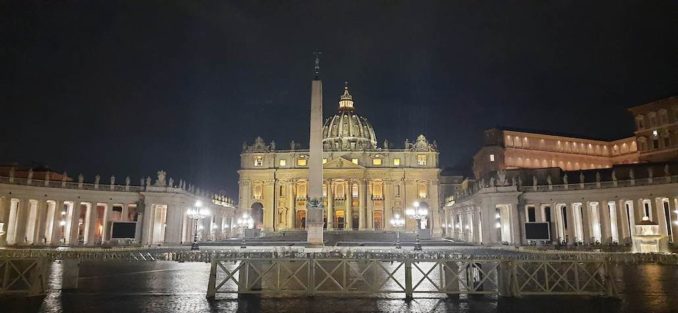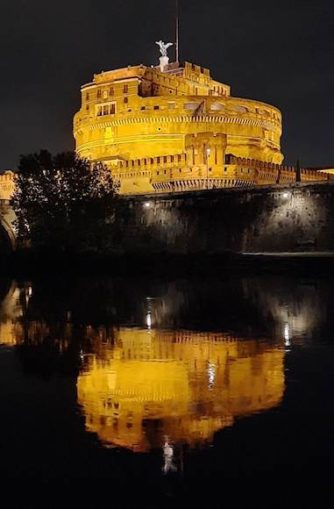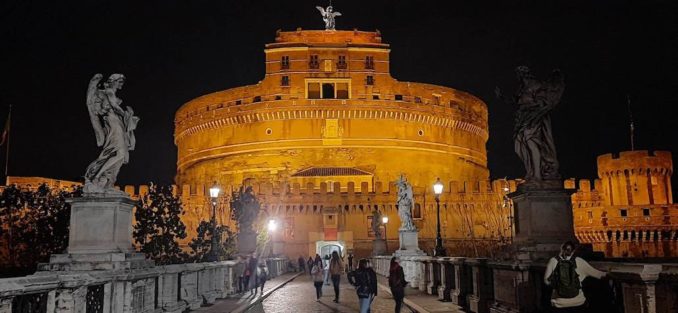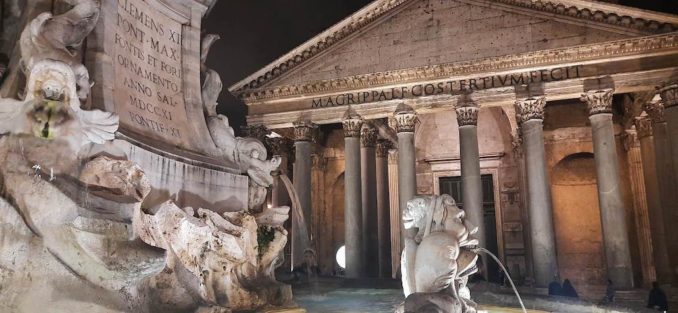We interrupt my grandparents’ 1950s Continental road trip to bring Puffins a contemporary photo montage just arrived via that modern-day family photo album that is Instant Messenger. Inspired by childhood dinner table tall tales of derring-do (perhaps somewhat exaggerated and occasionally slightly embellished) AWS Jr has struck out East and politely requests the following images be hung in the Explorers’ Room of the Going-Postal Gentleman’s (Ladies welcome) Club in Pall Mall.
St Peter’s Square

© AWS Jr 2023, Going Postal
St. Peter’s Square is a large plaza located directly in front of St. Peter’s Basilica in Rome’s Vatican City. At the centre of the square stands an ancient Egyptian obelisk, a large pink granite monument that stands at 83ft high and was originally a pagan solar symbol used for communication with the divine. It was built in Heliopolis, Egypt in honour of the sun and was brought to Rome by Emperor Caligula in 37 BC. It was re-erected in the centre of St. Peter’s Square in 1586 by Pope Sixtus V, who entrusted architect Domenico Fontana to create a wooden model to easily move it to its new location. The obelisk now contains a fragment of the true Cross and is surrounded by four bronze lions on a high pedestal. The transportation required 907 men, 75 horses, and 40 cranes and was completed in four months. In its Christianised form the obelisk is a symbol of humanity reaching out to Christ.
Behind the obelisk, which is flanked with fountains by Maderno a Bernini, can be seen the frontage of St. Peter’s Basilica. This masterpiece of Renaissance architecture features a grand colonnade that curves around the square. The colonnade is made up of 284 columns and 88 pilasters and symbolizes the embracing arms of the Catholic Church. The frontage of the basilica is topped by a large pediment and a series of statues representing Christ, John the Baptist, and the 11 Apostles.
Castel Sant’Angelo
A pleasant half-mile stroll along the Via Delle Concilliazone (or, if need be, a sprint along the top of the Passetto di Borgo with cassocks held above the knees) takes one to the Castel Sant’Angelo.
Also known as the Mausoleum of Hadrian, this fortress is located beside the Tiber and was originally built in 139 AD as a mausoleum for the Roman Emperor Hadrian. Converted into a castle in the 14th century, it was subsequently used as a papal residence, papal refuge, a treasure chamber, a prison and an execution site. It was given to the Italian army in 1870 and turned into a museum in the 20th century.

© AWS Jr 2023, Going Postal
The defensive walls of which it is a part were built in the 9th century to protect the Vatican City from attacks by Saracen pirates. The walls were later expanded and strengthened over the centuries, with the most recent renovations taking place in the 16th century under the direction of Pope Leo IV. The walls are about two miles long and 40 feet high, with 11 gates and 140 towers. Despite the present Pope’s enthusiasm for illegal immigrants, the walls and gates are still in use today and protect the Vatican City and His Holiness from potential threats.
The wall that runs direct from Castel Sant’Angelo to the Vatican is known as the Leonine Wall. In addition to the Leonine Wall, there is also the Passetto di Borgo, an elevated passage that links the Vatican City with the castle. The Passetto was erected in 1277 by Pope Nicholas III and served as an escape route for Popes in danger. Today, visitors can walk along the Passetto and see the historic wall and towers.
The bridge before the castle is the ancient Ponte Sant’Angelo which spans the Tiber River. It was completed in 134 AD by Emperor Hadrian, and has been renovated and restored several times since then. The bridge is known for its ten statues of angels, which were created by Bernini and his students in the 17th century. The angels are made of marble and stand over fifteen feet tall. Each one represents a different aspect of the Passion of Christ, such as the Crown of Thorns or the Lance of Longinus. The bridge and its statues are a popular tourist attraction in Rome today.

© AWS Jr 2023, Going Postal
The statue on top of Rome’s Castel Sant’Angelo is a beautiful bronze of St. Michael the Archangel. It was created by the Flemish sculptor Peter Anton von Verschaffelt in 1753 and stands tall with its sword drawn. The statue serves as a reminder of the appearance of the Archangel Michael. Legend holds that the Archangel appeared atop the mausoleum to halt a plague in the year 590 AD, thus lending the castle its present name.
As for Pope Nicholas III, his escape route to the castle proved redundant. Struck down by illness at his country retreat at Castro Soriano, Nicholas died so suddenly that he didn’t even have time to make a final confession. Having been Pope for only two years, eight months, and twenty-eight days and being of about 54 years in age, there is speculation he was poisoned.
The Pantheon

© AWS Jr 2023, Going Postal
After crossing the Tiber, another half-mile walk takes us through the Piazza Navona to the Piazza della Rotonda. Named after the rotunda-topped classical building known as the Pantheon which sits at its southern side. The Pantheon is a well-preserved ancient Roman monument beneath a massive dome. Originally the site of a temple, the Pantheon was commissioned by general and architect Marcus Agrippa during the reign of Emporer Augustus (27 BC-14 AD) to commemorate a military victory at the Battle of Actium in 31 B.C. Literally the ‘temple of all the gods’, it was rebuilt by Emperor Hadrian around 126-128 AD.
Since 609 AD, the Pantheon has been a Catholic church, dedicated to St Mary and the Martyrs.
Those of us who retain a smattering of schoolboy Latin might translate the inscription as M[arcus] AGRIPPA L[ucius] F[ilius] (son of Lucius) COS (consul) TERTIVM (three times) FECIT (built this). Closer to home, future historians will find AWS FECIT chiselled onto the various somewhat improvised contemporary improvements which have, how can I put it, altered the value of chez Worth-Saying.
By the Middle Ages a slum area, Pope Eugenius IV (1431–39) cleared a piazza to lay out and pave. The piazza is roughly rectangular, approximately 60 yards north to south and 40 yards east to west, with a fountain and obelisk in front of the Pantheon. The fountain is called the Fontana del Pantheon and is topped by another Egyptian obelisk. The fountain was constructed by Giacomo della Porta under Pope Gregory XIII in 1575. The obelisk was added in 1711 under Pope Clement XI.
The obelisk has done a Cooks tour of both the Mediterranean and Rome. Originally erected for the temple of Ra in Heliopolis by Pharoh Ramses II, it was brought to Rome in ancient times and erected in the Iseum Campense, a shrine to the Egyptian god Isis that stood to the southeast of its present location. Lost during the Dark Ages it was rediscovered in 1374 beneath the Basilica of Santa Maria Sopra Minerva in the Piazza della Minerva east of the Pantheon. Re-erected in the Piazza di San Macuto, there it remained until being but atop the Piazza della Rotondo fountain in the early 18th century.
Further recourse to schoolboy Latin suggests the inscription reads, CLEMENS XI PONT MAX (Clement 11th pontiff maximus, most high pontiff, ie Pope) FONTIS ET FORI ORNAMENTO ((possessive of) ornamental fountain and forum, ie Clem the XI’s fountain and forum) ANNO SAL[utus] (year of salvation – ie after the birth of Christ) MDCCXI (1,000 500 100 100 and 10 and 1 = 1711 AD).
I’d love to *cough* translate the hieroglyphs on the obelisk but, unfortunately, Jr couldn’t fit them in. One suspects they’ll be something to do with the rituals carried out on behalf of the sun god at Heliopolis.
© Always Worth Saying 2023


